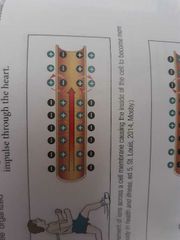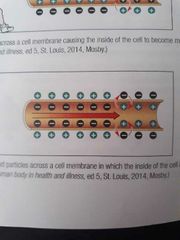![]()
![]()
![]()
Use LEFT and RIGHT arrow keys to navigate between flashcards;
Use UP and DOWN arrow keys to flip the card;
H to show hint;
A reads text to speech;
13 Cards in this Set
- Front
- Back
- 3rd side (hint)
|
Automaticity |
The ability of cardiac pacemaker cells to create an electrical impulse without being stimulated from another source |
|
|
|
Sinoatrial node (SA Node) |
The heart's normal pacemaker because of its capability of self-excitation at a rate quicker than that of other pacemaker sites in the heart |
|
|
|
Excitability |
The ability of cardiac muscle cells to respond to an external stimulus from either a chemical, mechanical, or electrical source. Also called irritability. |
|
|
|
Conductivity |
The ability of a cardiac cell to receive an electrical impulse and conduct it to an adjoining cardiac cell. All cardiac cells possess this characteristic, allowing an impulse in any part of the myocardium to spread throughout the heart |
|
|
|
Contractility |
The ability of myocardial cells to shorten, thereby causing cardiac muscle contraction in response to an electrical stimulus. Also called intropy. |
|
|
|
Polarization |

When the inside of a cell is more negative than the outside |
|
|
|
Depolarization |

Movement of charged particles across a cell membrane that causes the inside of a cell to become positive. This is an electrical event that must take place before the heart can contract and pump blood |
Stimulated |
|
|
Repolarization |

The movement of charged particles across a cell membrane in which the inside of the cell is restored to its negative charge |
Relax |
|
|
Refractoriness |
Describes the period of recovery that cells need after being discharged before they are once again able to respond to a stimulus |
|
|
|
Absolute refractory period |
The cell will not respond to further stimulation within itself. The myocardial working cells cannot contract and that the cells of the electrical conduction system cannot conduct an electrical impulse, no matter how strong the internal electrical stimulus |
|
|
|
Relative refractory period |
Begins at the end of the ARP and ends when the cell membrane is almost fully repolarized |
|
|
|
Effective refractory period (erp) |
Includes the arp and first half of rrp. A conducted action potential cannot be generated (i.e. there is not enough inward current to conduct to the next site) |
|
|
|
Supernormal period |
Follows the rrp. A weaker than normal stimulus can cause cardiac cells to depolarize during this period |
Dysrhytmias can develop during this period |

